In 1948, the United Nations declared that freedom, justice, and peace rely on a respect for human rights. A few decades later, a global campaign surfaced, advocating that this respect be extended to other animals, as well. This fight for animal rights stems from the idea that, as sentient beings, animals are entitled to the consideration and protection that has been afforded to humans, particularly the right to avoid suffering.
Advocates for animal rights consider anything less than this basic protection to be speciesism, a prejudice as irrational as that of racism or sexism. Critics, however, argue that humans are fundamentally different from nonhuman animals—only humans have developed moral systems, possess self-awareness and purpose, and can enter into a social contract; therefore, only humans possess inherent rights.
On this International Animal Rights Day, explore the history of animal welfare, rights, and law in the United States.
Key Moments in the American Animal Rights Movement
Brief Overview
Time and again over the course of U.S. history has the debate resurfaced, whether it be between farmers, factory owners, philosophers, scientists, or anyone else with interest in the animal kingdom. In the 1800s, organizations for animal protections and state anti-cruelty laws began to crop up across the nation. With an increase in industrialization came technological advancement and mass production, leading to more frequent scientific and cosmetic animal testing, as well as intensive agriculture—and therefore, industrial livestock production. Messages from the growing animal rights movement increased alongside the development of mass media, facilitating the passage of animal rights legislation.
For a detailed overview of key moments in the movement, view the timeline below.
Pre-Industrialization
- 1641: Colonists in Massachusetts Bay enact the first Western animal protection laws by including two anti-cruelty provisions in the colony’s Body of Liberties.
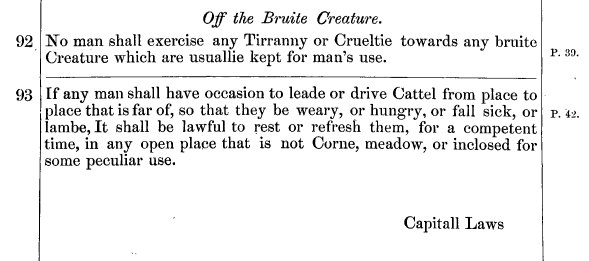
- 1828: The first state law against animal cruelty is passed in New York, making it a misdemeanor to maliciously kill, beat, torture, or maim horses, cattle, and sheep.
- 1835: Massachusetts becomes the second state to pass a state law against animal cruelty.
Post-Industrialization
Early Twentieth Century
- 1907: By this year, every state in the nation has passed an anti-cruelty statute. Find them all with HeinOnline’s State Statutes: A Historical Archive.
- 1923: Celia Steele becomes the first person in Delaware to raise chickens for meat, separate from egg production, and sells them for 67 cents per pound. In five years, she would process 10,000 chickens per year, becoming a pioneer of the intensive animal farming (a.k.a. factory farming) industry. Learn more about factory farming in this HeinOnline Blog post.
- 1940s: Various scientific and technological innovations help the animal farming industry grow, including the invention of de-beaking machines, mechanical feather pluckers, antibiotic food additives, and hybrid feeds.
- 1944: The Public Health Service Act is signed into law by Franklin D. Roosevelt, outlining responsibilities and authorities of the U.S. Health and Human Services Department. For its part in the story of animal rights, the act provided funding for more scientific research, leading to the discovery of vitamins A and D (allowing animals such as chickens to be kept inside without sunlight or exercise).
Mid-to-Late Twentieth Century
- 1951: The Animal Welfare Institute, a non-profit, charitable organization, is founded to reduce the amount of pain and fear inflicted on animals by humans.
- 1955: The Society for Animal Protective Legislation (SAPL), the eventual legal branch of the Animal Welfare Institute, becomes the first American organization to call for humane slaughter legislation.
- 1958: Following the efforts of SAPL, the Humane Slaughter Act is passed to limit the suffering of livestock during slaughter by requiring humane methods, such as pre-slaughter sedation.
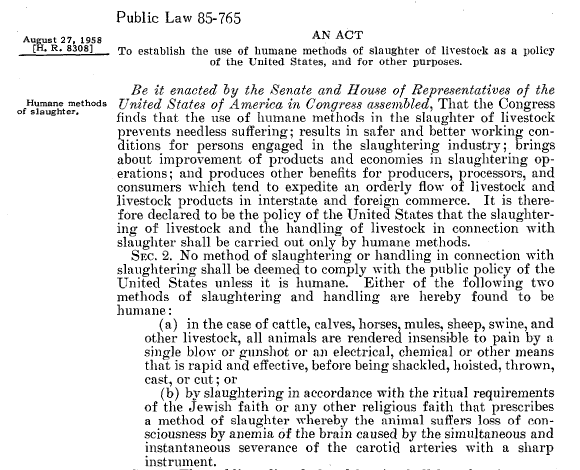
- 1966: President Lyndon B. Johnson signs the Animal Welfare Act (AWA) into law. It becomes the primary federal legislation that regulates standards for animal treatment in various industries, including exhibition and research.
- 1970: Congress amends the AWA to include all warm-blooded animals, whether they are cared for domestically, showcased in exhibits, or used for experimentation and testing. The standards for treatment are expanded to require humane handling of all specified animals, as well as suitable shelter, necessary sanitation, and proper veterinary care. After this first amendment, the act has been amended seven more times (1976, 1985, 1990, 2002, 2007, 2008, and 2013). The act does not cover birds, laboratory rats, laboratory mice, farm animals, or any cold-blooded animals.
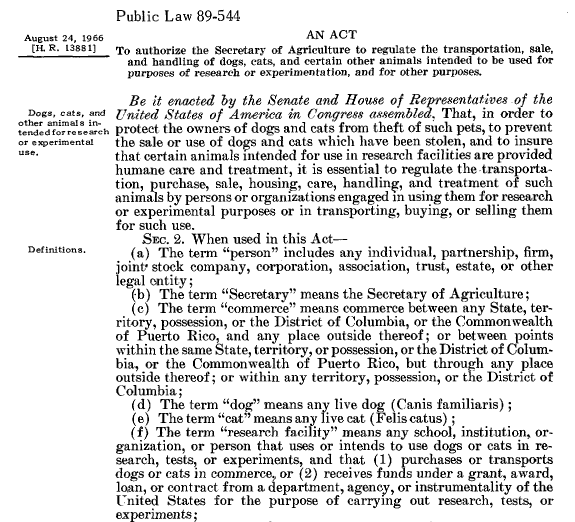
- 1976: Another amendment to the AWA prohibits the interstate or foreign transport of animals used for fighting, and creates standards for animal transport in other areas.
- 1979: The Animal Legal Defense Fund, an animal law advocacy organization, is founded.
- 1980: People for the Ethical Treatment of Animals (PETA) is founded by Ingrid Newkirk and Alex Pacheco.
- 1981-1983: The first police raid in the U.S. against an animal researcher occurs after Alex Pacheco of PETA performs an undercover investigation of a monkey research lab at the Institute for Behavioral Research. Unacceptable living conditions for the monkeys lead police to enter the Institute, remove the monkeys, and charge researcher Edward Taub with 17 counts of animal cruelty. Taub is convicted on six counts, but his final conviction is ultimately overturned in 1983. Taub’s discoveries with the monkeys go on to provide groundbreaking evidence about the plasticity of the adult brain, and help to develop a new form of therapy for human beings disabled due to brain damage.
- 1984-1985: The Animal Liberation Front (ALF), a clandestine resistance movement, steals sixty hours of audio and video tapes from the University of Pennsylvania’s Head Injury Clinic, a lab dedicated to studying head injuries by inflicting whiplash on baboons. The ALF provides the tapes to PETA, who sends the footage to both the press and to Congress. The lab is ultimately shut down, sparking concern in many in the biomedical research community that the government would submit to the pressures of activists, potentially harming future research efforts in the process.
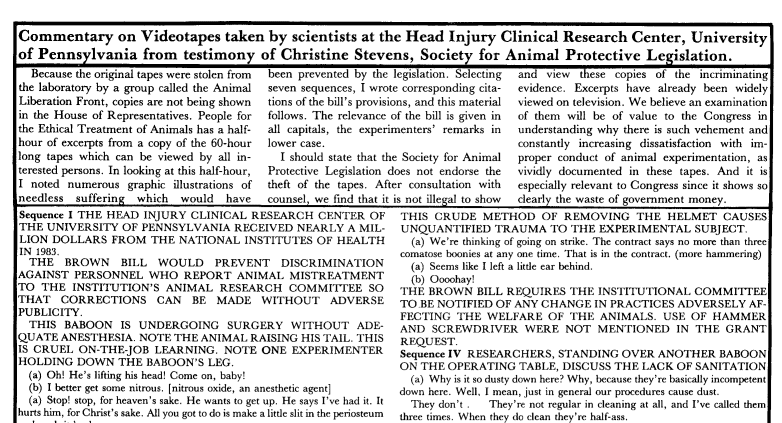
- 1985: After these events, Congress is moved to specifically define “humane care” for laboratory animals, passing the Improved Standards for Laboratory Animals Act in an amendment to the Food Security Act of 1985. The amendment establishes standards for sanitation, ventilation, housing, exercise, and animal distress, among other things.
- 1989: The Veal Calf Protection Act is introduced in the House due to growing societal concern over the welfare of calves in the veal industry, but the bill dies in Congress.
- 1992: The Animal Enterprise Protection Act is passed in response to concerns about recent examples of animal rights extremism—including vandalism, destruction, and other disruption—toward public and private enterprises using animals or animal-derived products. The law defines animal enterprise terrorism and establishes the disruption of an animal enterprise as a federal offense.
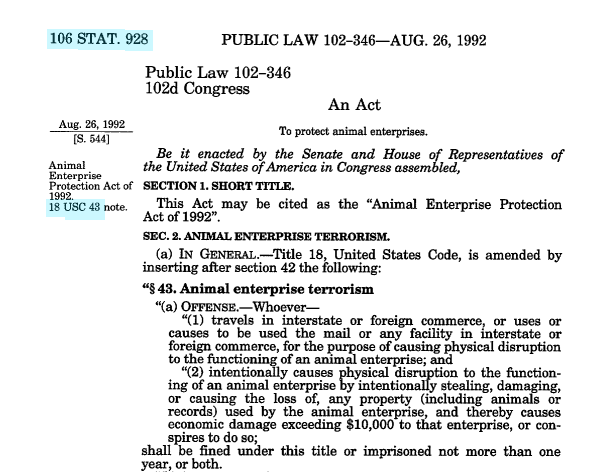
The Twenty-First Century
- 2006: The Animal Enterprise Protection Act is expanded to become the Animal Enterprise Terrorism Act. The act extends the definition of “animal enterprise” to include the academic and commercial sectors and classifies as a terrorist any person who damages the property of such an enterprise.
- 2013: For the first time, lawsuits are filed on behalf of chimpanzees, requesting they be granted the right to bodily liberty via the writ of habeas corpus. The intent of the lawsuit is to recognize the chimps under common law as autonomous entities, rather than property. All of the petitions are denied, but the mere fact that they are considered is seen as a significant boost to the animal rights movement.
- 2018: A bipartisan bill is passed to forbid the slaughter of cats and dogs for food in the United States. The Dog and Cat Meat Trade Prohibition Act imposes a fine of up to $5,000 for anyone who sells, ships, or transports these animals for the purpose of human consumption (with the exception of religious or ritual slaughter).
- 2019: California becomes the first state to ban products derived from animal fur. To compare state laws on other animal rights-related issues, use the Animal Welfare chapter in HeinOnline’s National Survey of State Laws database.
A Dedicated Animal Studies Database from HeinOnline
Interested in learning more about the context of these events, or other issues in the debate about animal rights? Use HeinOnline’s Animal Studies: Law, Welfare and Rights database. This collection includes nearly 2,300 titles and more than 630,000 pages relating to the background, evolution, and future of the basic rights of animals. From philosophical books dating back to the 1800s to relevant government documents and analytical videos, brochures, and scholarly articles, the database provides an overview of foundational animal-related legislation while following the evolution of animal rights throughout the years.
Discover more than 100 animal-related legislative histories covering relevant subjects such as animal drug testing, fishery conservation, endangered species, and more. More than a thousand historical and current books, periodicals, and articles have also been included by our editors for their discussion of animal welfare, protection laws, international wildlife laws, and other related topics. In addition, locate more than 800 congressional hearings and GAO reports on animal-related legislation. Finally, Title 9 and Title 50 of the Code of Federal Regulations and more than 100 titles from the Animal Legal Defense Fund and Animal Welfare Institute round out this essential resource for the study of animals in human society.



